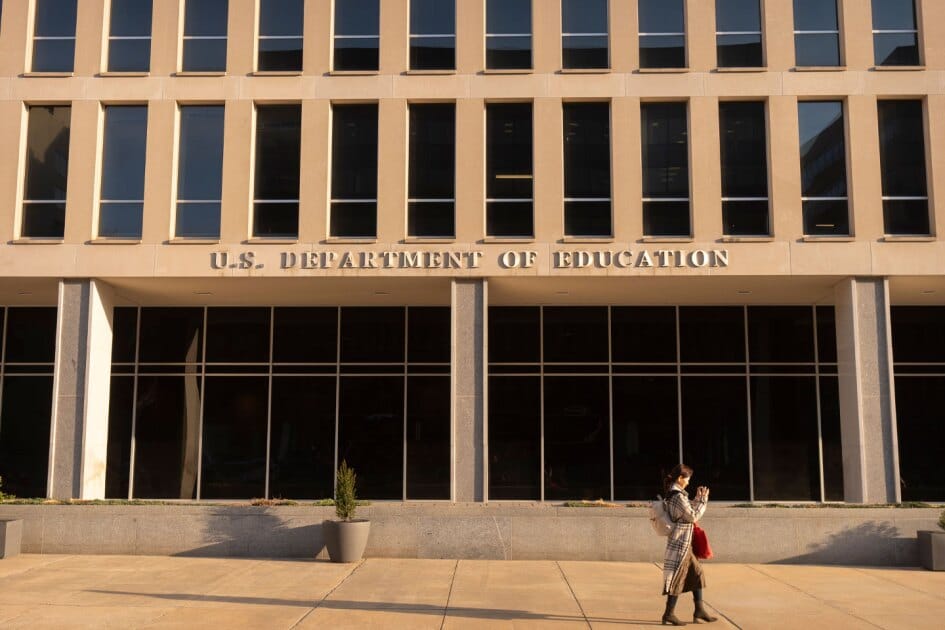The U.S. Department of Education can proceed with firing nearly half its civil rights enforcement staff as part of its broader downsizing effort, a federal appeals court decided this week, in a move that overturns the last court order still in effect that had directed the Trump administration to reinstate laid-off agency employees.
The decision from a three-judge panel of the 1st Circuit Court of Appeals in Boston, issued Monday, comes as the department had, under that lower-court order, slowly begun bringing back the 264 office for civil rights employees it had planned to let go in a seismic layoff earlier this year. The department brought back 85 employees in September, and planned to bring back another 60 every two weeks through the start of November, according to a recent court filing.
But the department has repeatedly signaled it would shed those staff as soon as it got the greenlight. Following a July Supreme Court decision that paved the way for the department to continue with the layoffs of hundreds of other Education Department employees, an email to OCR employees said they would be “separately notified of their separation at the appropriate time.” The Trump administration had appealed to the 1st Circuit in an attempt to overturn the lower-court order forcing it to bring back only OCR staff.
On Tuesday, in the immediate aftermath of the appeals court decision, staff expecting to be reinstated said the department hadn’t yet reached out regarding the court’s decision and had continued to receive communication about returning to work.
Office for civil rights employees are responsible for enforcing federal civil rights laws in schools, investigating complaints and working with schools and colleges to bring them into compliance. The appeals court’s Monday decision stemmed from a lawsuit brought by the Victim Rights Law Center, which represents sexual assault survivors, and the parents of two boys—one in Michigan and one in Nebraska—who had pending civil rights cases that OCR had paused.
The Education Department didn’t immediately respond to a request for comment on Tuesday on its next steps.
A spokesperson for the Victim Rights Law Center said the layoffs were an “ill-conceived political move.”
“OCR exists to safeguard students’ educational access, especially those who have faced discrimination or experienced sexual assault. Without adequate staffing, that is impossible,” the spokesperson continued. “We remain optimistic that we will ultimately prevail, but are heartbroken for the students who will be denied important academic and extracurricular opportunities while we wait for that day to come.”
The Supreme Court’s July order was decisive in the appeals court order
The panel of judges from the U.S. Court of Appeals for the 1st Circuit ultimately sided with the Trump administration, which argued that the court should apply the July U.S. Supreme Court decision that allowed for broader cuts at the Education Department to this narrower case dealing with layoffs in only one division of the agency.
That Supreme Court’s decision ultimately colored how the appeals court judges viewed the OCR case.
Both orders telling the Trump administration to reinstate laid-off Education Department employees came from the same Massachusetts-based U.S. District Court judge, Myong Joun. In each order, Joun, an appointee of former President Joe Biden, had agreed with plaintiffs who argued the layoffs would hamper the department’s ability to carry out its congressionally mandated role.
While the Supreme Court did not provide an explanation or outline its legal reasoning in its July order, the 1st Circuit judges wrote in their opinion Monday, “at this preliminary stage of the litigation, … we cannot conclude that this [OCR] case differs enough” from the case concerning broader Education Department layoffs to reach a different decision.
The distinctions between the cases were “insufficiently material” to justify “a different stay outcome here,” two of the three judges—Lara Montecalvo and Julie Rikelman, both Biden appointees—wrote in their opinion.
Seth Aframe, the third judge and also a Biden appointee, agreed but wrote a separate, concurring opinion.
What happens next is still unclear
The office for civil rights was one of the hardest-hit divisions in the March downsizing that came as part of President Donald Trump’s pledge to eliminate the Education Department. One of the largest civil rights enforcement bodies in the federal government, OCR had about 560 employees and 12 regional offices before the March layoffs. In addition to the layoffs of more than 260 staffers, the Education Department closed seven of the division’s regional offices.
Despite its smaller size, OCR has become the main enforcer of Trump’s social policy in schools, opening cases cracking down on policies allowing transgender students access to athletic teams and school facilities aligned with their gender identity, and diversity, equity, and inclusion programs.
Former staff have worried that OCR wouldn’t be able to balance its typical caseload with Trump’s identified priorities.
But while the Trump administration pursued appeals, the Education Department began to bring staff back, in compliance with Joun’s order, which he initially issued in June, then declined to drop following the Supreme Court’s July decision in the broader layoffs case.
The department gave employees roughly a week’s notice that they were in the next wave of staffers returning to work, issuing new laptops, providing information about ID cards, and asking staff to report to work remotely while it identified office space—even for staff whose assigned offices weren’t shuttered.
It wasn’t immediately clear Tuesday what would happen to the 85 employees who have already returned to work, or the employees slated to return to work as soon as next week.
2025-09-30 17:48:01
Source link

